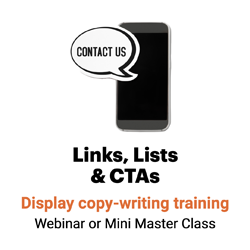Get the word out to lookers, skimmers & readers
Online readers read shallow and deep, according to The Stanford Poynter Project: Eye Movement on the Internet, a study by Stanford University and The Poynter Institute.

So how can you give your in-depth “divers” enough information without overwhelming your casual “surfers”?
“The Internet is for everybody,” write Daniel A. Cirucci and Mark A. Tarasiewicz of the Philadelphia Bar Association. “It’s for the 30-second reader, the three-minute reader, the 30-minute reader and even the three-hour junkie.”
So how do you serve all these groups?
Write for three audience groups.
Present each message for:
- Lookers, who may give you 10 seconds. Get these folks’ attention with a sharp headline and large image.
- Skimmers, who may give you 30 seconds. Reach them through display copy: headlines, decks, subheads, links and bold-faced lead-ins, for instance.
- Readers, who may give you 2 minutes. These folks may read the paragraphs.
Writing for the Web author Crawford Kilian calls them:
- Viewers, “those looking for entertainment, who think dancing boloney is fun”
- Users, “those who go to the web to get information they need for specific purposes”
- Readers, “those who are willing to put up with poor screen resolution so that they can actually read something that interests them”
And branding guru Bob Killian suggests writing for three groups:
1. Quals, or people who just want to hear your brand story plus maybe one proof point. They make up 86% of your human audience, Killian estimates, and 86% of your best prospects, as well.
“When they land on your home page, they’ll give you 4.5 seconds to make clear we-make-widgets-that-wiggle, and we-ship-globally-in-24-hours. (One defining story, one meaningful differentiator),” he writes. “If the first paragraph is ten lines long, they bail out. If you layer on 10-reasons-why, they … bail out.”
2. Quants, or folks people who also want to know your proofs and processes.
Quants “will read the nutrition chart on the peanut butter jar, read the prospectus, read the insurance policy, and so on,” Killian writes.
“They want more than your story; they want drill-down data about ingredients, processes, testimonials, proof statements of any kind – they’ll even sit still for 10 reasons why. These data points can’t be ignored since they are 14% of your human visitors.”
3. Bots, or search engine robots. They’re looking for the same level of detail as the Quants.
How do you reach all of these folks?
Write shallow, deliver deep.
For the web, you may need to write shorter, making each web page as tight as possible. But you also need to deliver longer pieces for your deep divers.
“Open with kernels for the 30-second reader,” write Cirucci and Tarasiewicz. “Break to bits for the three-minute reader. Branch to detail for the 30-minute reader. Link to verbal and visual feasts for the three-hour junkie.”
As Eric Morgenstern, president and CEO of Morningstar Communications, counsels, offer your readers:
- USA Today level
- Wall Street Journal level
- Harvard Business Review level
Let them choose.
Or, if you, like I, are more inclined to favor a bacon analogy, think of these layers as:
- Amuse bouche
- Appetizer
- Entree
Or, as one PR pro (whose name I’ve lost) put it:
- Bite
- Snack
- Meal
For an executive speech, for instance, you might offer:
- A headline and summary blurb on the homepage
- A one-page summary of speech highlights
- The full text of the speech
- The speech in streaming audio and video
Visitors can surf as shallowly or dive as deeply as they prefer.
“There’s a story to make obvious, and drill-down stuff to make available,” Killian says. “Never confuse the two.”
Move readers up the attention ladder.
The good news is, you may be able to move these folks up the ladder of attention. If the 10-second view is interesting enough, you might turn a looker into a skimmer. If the display copy delivers real value, you might turn a skimmer into a reader.
But even if you don’t move visitors up the attention ladder, you need to reach each group where they are. You need to write for all of your readers.

Leave a Reply